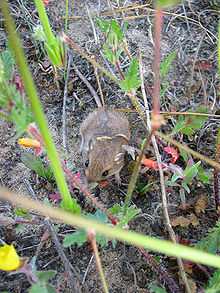Perognathus
| Perognathus Temporal range: Early Miocene - Recent | |
|---|---|
 | |
| Perognathus longimembris pacificus | |
| Scientific classification | |
| Kingdom: | Animalia |
| Phylum: | Chordata |
| Class: | Mammalia |
| Subclass: | Eutheria |
| Order: | Rodentia |
| Family: | Heteromyidae |
| Genus: | Perognathus Wied-Neuwied, 1839 |
| Species | |
|
Perognathus alticola | |
Perognathus is a genus of pocket mouse. Like other members of their family they are more closely related to pocket gophers than to true mice.
Characteristics
The silky pocket mice are small animals with soft pelage, long tails, and small feet compared to other heteromyids. They have long claws which are used for digging burrows and sifting sandy substrates for seeds. They have also been found to steal seeds from kangaroo rats' dens. They store these seeds in large hairy external cheek pouches. They are nocturnal and are found in arid habitats. They are not true hibernators, but will go into torpor and stay in their burrows for extended periods of time.
Species
- Perognathus alticola – White-eared pocket mouse
- Perognathus amplus – Arizona pocket mouse
- Perognathus fasciatus – Olive-backed pocket mouse
- Perognathus flavescens – Plains pocket mouse
- Perognathus flavus – Silky pocket mouse
- Perognathus inornatus – San Joaquin pocket mouse
- Perognathus longimembris – Little pocket mouse
- Perognathus merriami – Merriam's pocket mouse
- Perognathus parvus – Great Basin pocket mouse
Sometimes members of the genus Chaetodipus are placed in Perognathus.
References
- Duff, A. and A. Lawson. 2004. Mammals of the World A Checklist. New Haven, Yale University Press.
- Nowak, Ronald M. 1999. Walker's Mammals of the World, 6th edition. Johns Hopkins University Press, 1936 pp. ISBN 0-8018-5789-9